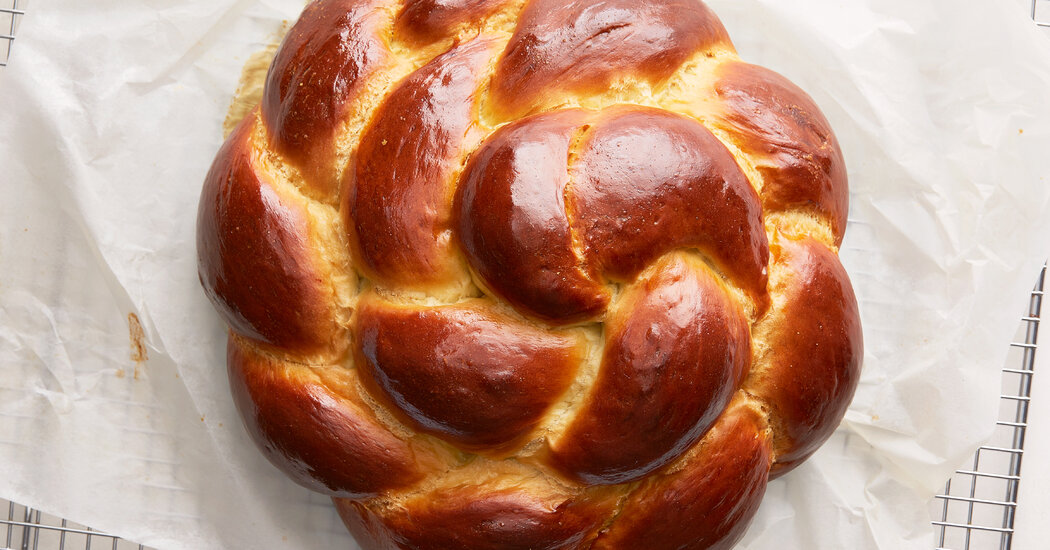
If you don’t have the patience for breadmaking (or for baking at all), chances are you’ll still find challah, the enriched bread often served on the Jewish sabbath and during the High Holy Days, not only manageable — but fun.
Compared with more technical breads, like sourdough loaves or baguettes, challah is mostly hands-off, with an easy-to-handle dough. Plaiting it into a braid is pleasantly tactile, and the end result always looks impressive, even if your braiding skills are average. The loaves are also versatile, lending themselves equally well to sweet preparations (bread pudding and cinnamon toast) and savory ones (sandwiches and accompaniments to soups, stews and saucy braises).
But challah is still bread, so all the principles of sound breadmaking — fermentation, bakers’ percentages and gluten development, to name a few — apply.
Some challah recipes, however, tend to gloss over those concepts, making pitfalls like undermixing and underproofing more likely and yielding bread that isn’t as silky and light as it could — and should — be. As a challah-lover and avid home bread baker, I wanted to create a classic recipe that not only has a rich, lightly sweet crumb and thready, pull-apart texture, but also integrates core breadmaking techniques to maximize your chances at success.
This particular recipe is forgiving, flexible and doable in a day. And that it’s rooted in technique makes it a fantastic gateway bread. If you’re bread-curious but not sure where to begin, start here. With Rosh Hashana starting on the evening of Sept. 25, make it now so you can enter the holiday baking season with a bit of bread experience under your belt.
Start With a Sponge
Many challah recipes call for mixing an unusually high proportion of yeast directly into the dough. Because active dry yeast, the most common yeast for home bakers, isn’t very efficient in a high-sugar, low-moisture dough like challah, adding a lot of yeast accelerates fermentation.
But a more rapid fermentation comes at the expense of taste and texture. So instead, I take the extra step of making a sponge by mixing a portion of the flour with water and a small amount of yeast. Similar to a sourdough starter but made with commercial yeast rather than wild yeast, a sponge is a type of preferment that is later mixed into the dough. As the sponge sits, the yeasts feed on the starches in the flour and multiply, making the mixture active and bubbly and removing the need to add additional yeast to the final dough. This extra fermentation time leads to bread with a much-improved texture, aroma and flavor.
Finding Ingredient Balance
Also worth noting about the recipe are the proportions of salt and flour, and the mixing method. Generally, the weight of salt in a bread dough should equal 2 percent of the total flour weight, and even several pinches will fall well short of that for the average loaf of challah. Salt brings out the dough’s flavor and strengthens the gluten network, leading to a well-formed loaf. The 11 grams of salt here may seem like a lot (especially if you’re watching your sodium), but it’s the correct amount.
The quantity of bread flour, in contrast, is left somewhat flexible to account for variation in how different brands absorb liquid. This recipe purposefully undershoots how much flour you’ll need and has you add more little by little during the kneading process until the dough texture is firm, elastic and supple yet slightly tacky. (While you could use a stand mixer, I prefer to knead by hand, as it allows you to better assess the dough.)
A high proportion of olive oil (my fat of choice for challah, as it adds flavor and keeps it pareve, meaning it’s compatible with meat and dairy according to kosher rules) inhibits gluten formation, so challah dough needs lots of kneading. Common in breadmaking, the windowpane test helps determine if you’ve developed sufficient gluten: Pinch off a golf ball-size piece of dough, flatten it, then slowly and gently stretch it outward in all directions until it’s so thin that light can pass through. Hitting this mark ensures the crumb comes out bready and stretchy instead of crumbly.
Let It All Take Shape
You can configure the dough into any shape you like — a round loaf with raisins, for example, is traditional for Rosh Hashana — but I think the most beautiful rendering is a six-strand braid. It looks like a smaller braid woven into the surface of larger braid, creating wonderful height and dimension. As it’s one of the more complex braiding techniques, you might want to practice with ribbon beforehand, or feel free to fall back on a simpler three-strand braid.
These details might make challah sound more complex than it really is, but in fact the undertaking is fairly straightforward. The various tests built into the recipe (and which will be familiar to many home bread bakers) will help you achieve the light but rich, supple and soft texture essential to good challah.
Once you have a feel for the process, you’re well positioned to try other breads like focaccia or a sandwich loaf. But challah is so wonderfully versatile that I wouldn’t be surprised if you decided to stick with it for a while. Try your hand at different braiding techniques, make lots of French toast and even use the dough to bake hamburger buns, sweet rolls and this fragrant cinnamon babka. It’s good and easy enough to be your one-and-only bread.
Recipes: Challah Bread | Cinnamon Babka



